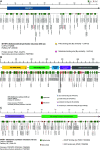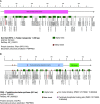Synthetic combinations of missense polymorphic genetic changes underlying Down syndrome susceptibility
- PMID: 27245382
- PMCID: PMC11108497
- DOI: 10.1007/s00018-016-2276-0
Synthetic combinations of missense polymorphic genetic changes underlying Down syndrome susceptibility
Abstract
Single nucleotide polymorphisms (SNPs) are important biomolecular markers in health and disease. Down syndrome, or Trisomy 21, is the most frequently occurring chromosomal abnormality in live-born children. Here, we highlight associations between SNPs in several important enzymes involved in the one-carbon folate metabolic pathway and the elevated maternal risk of having a child with Down syndrome. Our survey highlights that the combination of SNPs may be a more reliable predictor of the Down syndrome phenotype than single SNPs alone. We also describe recent links between SNPs in p53 and its related pathway proteins and Down syndrome, as well as highlight several proteins that help to associate apoptosis and p53 signaling with the Down syndrome phenotype. In addition to a comprehensive review of the literature, we also demonstrate that several SNPs reside within the same regions as these Down syndrome-linked SNPs, and propose that these closely located nucleotide changes may provide new candidates for future exploration.
Keywords: Folate; MTHFR; Missense; One-carbon metabolism; Polymorphism; SNP; Trisomy 21; p53.
Conflict of interest statement
The authors declare that they have no competing interests.
Figures




References
-
- Fonatsch C. The role of chromosome 21 in hematology and oncology. Genes Chromosomes Cancer. 2010;49:497–508. - PubMed
Publication types
MeSH terms
Substances
LinkOut - more resources
Full Text Sources
Other Literature Sources
Medical
Research Materials
Miscellaneous

